Meta di Sorrento
Artistic Itinerary
Religious and civil itinerary
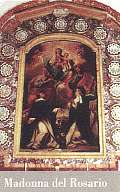 Maria del Lauro rose up in the locality of the Temple of Minerva. Initially dedicated to the Savior, was called "The Madonna del Lauro" in 1206, after a pious woman from Meta had found a statue of the Virgin under a laurel tree (VIII cent. B.C.). Today the building has a neo-classical facade accompanied by a robust bell tower in baroque style, surmounted by a low tiled dome.
Maria del Lauro rose up in the locality of the Temple of Minerva. Initially dedicated to the Savior, was called "The Madonna del Lauro" in 1206, after a pious woman from Meta had found a statue of the Virgin under a laurel tree (VIII cent. B.C.). Today the building has a neo-classical facade accompanied by a robust bell tower in baroque style, surmounted by a low tiled dome. 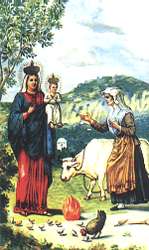 The interior of the Basilica is elegant and full of light. It is in the shape of a Latin cross with three aisles divided by fourteen pillars. It is adorned with prestigious marble, stucco work, gold and works of art. Behind the metal entrance doors there is a wooden door, preserved since the second half of the 1500s, with twentyfour shapes carved in teak illustrating the Mysteries of the Rosary. To the right of the presbytery there is the chapel of the Madonna del Lauro inlayed in marble in the 1700s; frescoes (the Evangelists) by Giuseppe Bonito (1785) adorn the lower parts of the smaller domes; at the alter there is an old statue of the Virgin carved in wood of the lime tree. On the sides of the presbytery there are frescoes of the Guardian Angel and
The interior of the Basilica is elegant and full of light. It is in the shape of a Latin cross with three aisles divided by fourteen pillars. It is adorned with prestigious marble, stucco work, gold and works of art. Behind the metal entrance doors there is a wooden door, preserved since the second half of the 1500s, with twentyfour shapes carved in teak illustrating the Mysteries of the Rosary. To the right of the presbytery there is the chapel of the Madonna del Lauro inlayed in marble in the 1700s; frescoes (the Evangelists) by Giuseppe Bonito (1785) adorn the lower parts of the smaller domes; at the alter there is an old statue of the Virgin carved in wood of the lime tree. On the sides of the presbytery there are frescoes of the Guardian Angel and 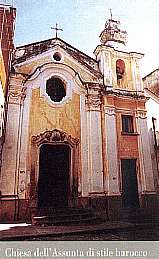 Saint Michael (1640); in the apse, from the Neapolitan school of the 1700s, there is a statue of Christ Resurrected. At the altar of the left transept, from the Neapolitan school of the 1500s, there is the Madonna del Rosario surrounded by the Mysteries. In the sacristy you can admire the frescoes of Costantino Desiderio (1783) symbolizing the triumph of faith; a magnificent painting by Luca Giordano depicting Jesus casting out the merchants from the temple of Jerusalem and some inlayed wooden wardrobes (1765). Resulting from the proposal of the art historian Antonio Filangieri di Candida, the Sanctuary of Meta was declared a Monument by Ministerial Decree of 29th November, 1913.
Saint Michael (1640); in the apse, from the Neapolitan school of the 1700s, there is a statue of Christ Resurrected. At the altar of the left transept, from the Neapolitan school of the 1500s, there is the Madonna del Rosario surrounded by the Mysteries. In the sacristy you can admire the frescoes of Costantino Desiderio (1783) symbolizing the triumph of faith; a magnificent painting by Luca Giordano depicting Jesus casting out the merchants from the temple of Jerusalem and some inlayed wooden wardrobes (1765). Resulting from the proposal of the art historian Antonio Filangieri di Candida, the Sanctuary of Meta was declared a Monument by Ministerial Decree of 29th November, 1913.
Minor expressions of Neapolitan baroque
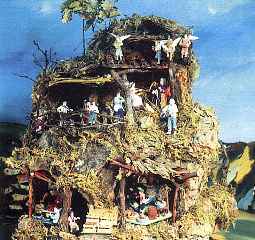 In numerous chapels in Meta you can find less important examples of Neapolitan baroque art: Santa Maria delle Victoria, Casa Starita; Santa Maria di Loretta, Pontemaggiore; Santa Maria della Misericordia, Via Vocale; Santa Maria delle Grazie, Via Cassari; SS. Angeli Custodi; Assunta, Trivio; SS Annunziata, commonly called Santa Lucia; Santa Maria delle Grazie, Rivo. The baroque style in a large number of chapels in Meta dedicated to the Madonna under various titles seem to abandon the emphasis of the Madonna del Lauro for a different language. The same modesty and limitations of the projects have used a minor tone of expression and more folklore and common poetry.
In numerous chapels in Meta you can find less important examples of Neapolitan baroque art: Santa Maria delle Victoria, Casa Starita; Santa Maria di Loretta, Pontemaggiore; Santa Maria della Misericordia, Via Vocale; Santa Maria delle Grazie, Via Cassari; SS. Angeli Custodi; Assunta, Trivio; SS Annunziata, commonly called Santa Lucia; Santa Maria delle Grazie, Rivo. The baroque style in a large number of chapels in Meta dedicated to the Madonna under various titles seem to abandon the emphasis of the Madonna del Lauro for a different language. The same modesty and limitations of the projects have used a minor tone of expression and more folklore and common poetry.
Villa Liguori
Villa Liguori was built in 1773. Its present form has been enlarged and redesigned. During the years there have been numerous thefts of 19th century vases and statues and notable damage from the earthquake in 1980.
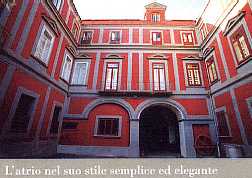 Palazzo Fienga
Palazzo Fienga
We do not know the actual date of construction of Palazzo Fienga. The portals, which are engraved in lava stone, are all that remain of the original facade and are 17th century baroque. The adjustment of the property happened in the 1700s and we assume that Vanvitelli was involved as he was a leading supporter of the classical trend and he did not distain figurative and spacious themes.
Villa Elisa
Villa Elisa is an 18th century nobile building belonging to the Mastelloni family, Duke of Laureana, Marquis of Pannarano and Corigliano. Recently restored, after being in ruins for many years.
Villa Valletta Martini
Villa Valletta Martini is another beautiful 18th century dwelling, it was fabricated in two parts: the first part with its magnificent portals, form the courtyard which led to the orange grove pertaining to the villa; the second, the real and true villa which also comprised a gracious nobile chapel with a painting by Guido Reni.
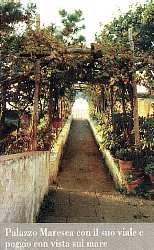 Villa Giuseppina
Villa Giuseppina
The imposing Villa Giuseppina from the Vanvitelliana school was built in 1739. It has belonged to a few owners: the Borboni until 1840; Luigi Cosenza, who lived there for many years; in 1978 it was divided into seven apartments and sold to as many people.
Palazzo Maresca
The house of engineer Mario Maresca is inserted into a much bigger building organism, formed from a convent built at the begining of the 17th century.
- Historical Itinerary
- Naturalistic Itinerary
Artistic Itinerary